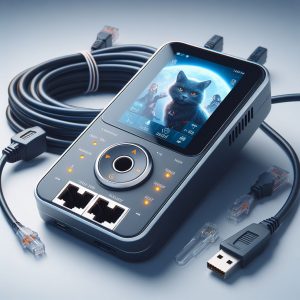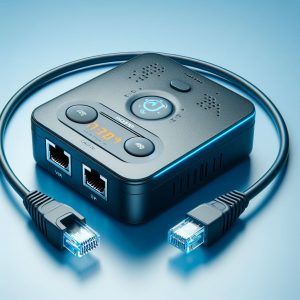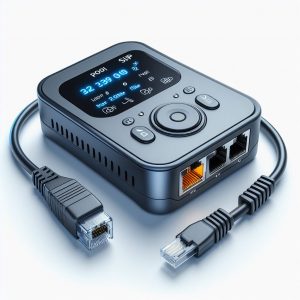I. Introduction
A. Definition of VoIP Adapter
A VoIP (Voice over Internet Protocol) phone adapter, also known as an analog telephone adapter (ATA), is a device that allows you to use traditional analog phones, fax machines, and other analog devices on digital Voice over Internet Protocol (VoIP) phone networks. The adapter converts analog signals into digital data that can be transmitted over the internet, and vice versa.
B. Importance in bridging analog and digital networks
VoIP adapters play a crucial role in bridging legacy analog telephone systems with modern digital VoIP networks. As businesses transition their phone systems to VoIP for cost savings and advanced capabilities, VoIP adapters allow them to continue using existing analog phones, fax machines, modems, and other analog devices that rely on traditional telephone networks. The adapters seamlessly integrate these devices into the new digital systems. VoIP adapters also enable consumers to use their regular home phones with VoIP services provided by their cable company or third party providers. Overall, VoIP adapters facilitate the adoption of VoIP technology by enabling backwards compatibility.
II. What is a VoIP Adapter?
A. Functionality
1. Bridging analog and digital signals
The core functionality of a VoIP adapter is to bridge the gap between analog and digital voice communications. It provides the following signal conversions:
- Analog (voice, fax) to digital – The VoIP adapter takes the analog audio signals from traditional phones and converts them into digital packets that can be transmitted over the internet. This allows sending and receiving calls over VoIP networks.
- Digital to analog – In the other direction, the adapter converts the digital VoIP audio back into analog signals that can be output by conventional phones. This allows analog phones to receive VoIP calls.
2. Connecting analog devices to VoIP services
VoIP adapters allow analog telephones, fax machines, modems and other analog equipment to access and use VoIP phone services. This includes:
- Connecting regular home phones to residential VoIP services like those from cable providers
- Integrating office analog phones and fax machines with business VoIP phone systems
- Enabling analog devices to utilize VoIP features like call routing, voicemail to email, call recording and more.
B. Technical overview
1. Connection to local area network
VoIP adapters connect to the local area network via an ethernet port or WiFi. This allows them to access the VoIP phone system which is normally hosted on a private business network or by a residential VoIP provider. The adapter links analog devices to the same network.
2. Integration with analog phone systems
The VoIP adapter integrates with existing analog telephone systems using RJ-11 FXS (“foreign exchange station”) ports. Analog phones or other devices plug directly into the FXS ports on the adapter using standard telephone cables. Multiple ports allow connecting multiple analog devices. The adapter appears just like a regular phone line to the attached analog equipment.

III. How Does a VoIP Adapter Work?
A. Signal conversion process
1. Analog to digital and vice versa
VoIP adapters work by converting analog signals to digital packets, and vice versa:
- Analog to digital: The adapter takes the analog voice signal from a traditional phone handset and converts it into a digital signal using a codec (coder-decoder). This digitizes the voice so it can be assembled into IP packets and transmitted over the internet. Popular codecs used by VoIP adapters include G.711, G.729 and G.722.
- Digital to analog: In the reverse direction, the incoming digital VoIP data (packets) from the network are extracted by the adapter and decoded back into an analog voice signal using the codec. This analog signal can then be output to a regular phone handset to be heard by the recipient.
This bidirectional conversion between analog and digital domains is what allows the two technologies to interconnect and talk to each other.
B. Integration with VoIP systems
1. Call routing and queuing for efficiency
VoIP adapters seamlessly integrate with VoIP phone systems to enable efficient call routing and management:
- When an analog phone connected to the adapter makes a call, the adapter forwards the signaling and digitized voice data to the VoIP phone system.
- The VoIP system handles call routing, call switching, call forwarding, dial plans and other call management features.
- During high call volumes, calls may be queued and switched efficiently using the VoIP system before sending the voice signals back to the adapter for analog output.
- The adapter essentially acts as an analog end-point for the digital VoIP network while handling the analog to digital conversion.
This tight integration allows businesses to retain the flexibility and features of their VoIP phone systems while getting analog devices online.
IV. Types of VoIP Adapters
There are two main types of VoIP adapters used to connect analog devices to VoIP networks:
A. Analog Telephone Adapter (ATA)
An analog telephone adapter (ATA) is a device that acts as a gateway to connect one or more standard analog phones to a VoIP network. It is the most common and cost-effective type of VoIP adapter used by residential customers and small businesses.
Key features of an ATA include:
- RJ-11 FXS ports to connect analog phones using regular phone cables
- RJ-45 ethernet port to connect to a router or modem for VoIP network access
- Built-in codec to convert signals between analog and digital formats
- Dial tone simulation to make the VoIP system seem like a normal phone line
- Call features like call waiting, caller ID, call forwarding etc.
Popular ATAs include the Linksys PAP2, Obihai OBi200, Cisco SPA112, Grandstream HT802 etc. ATAs are sold by VoIP providers or purchased standalone. They aim to be simple plug-and-play devices for easy analog phone usage over VoIP.
B. SIP Adapter vs. VoIP Gateway
For larger businesses with PBX phone systems, the choice is between a SIP adapter or VoIP gateway to integrate analog devices:
1. Technical capabilities and cost-effectiveness
SIP Adapter
- Designed for use with SIP (Session Initiation Protocol) based VoIP PBX systems
- Acts as a SIP endpoint registering directly to the SIP PBX
- Handles SIP signaling and voice digitization
- Cost-effective solution for small to medium business needs
VoIP Gateway
- More advanced capabilities compared to a SIP adapter
- Can register multiple SIP endpoints from various analog devices
- Extra features like local voice switching without sending data to the IP PBX
- More expensive but can handle larger numbers of device integrations
Generally, SIP adapters are used by small businesses while large enterprises use VoIP gateways to integrate their legacy analog infrastructure. The right solution depends on the technical needs and budget.

V. Using VoIP Adapter with Wireless Network
A. Benefits of wireless connectivity
Using a VoIP adapter over WiFi and wireless networks provides benefits like:
- Flexibility – Phones can be used without stranded wires running through the building. Users can move around while on voice/video calls.
- Cost savings – No need for rewiring or installing ethernet cables to use VoIP adapters. WiFi is generally already available.
- Scalability – Its easy to add more analog phones by just plugging into available adapters. No need to run additional wires or cables.
B. Tips for seamless integration
1. Utilizing wireless bridges for stability
For best performance, plug the VoIP adapter into a wireless bridge connected to the WiFi router rather than connecting directly. Wireless bridges provide a stronger and more stable signal which is important for VoIP call quality.
2. Connecting IP phones for cost-effective calling
Combine analog adapters with a few VoIP wireless IP phones. IP phones allow making VoIP-to-VoIP calls within the network at no cost without needing the analog conversion. This reduces load on the limited adapters.

VI. Conclusion
A. Growing importance of VoIP adapters in residential and business settings
As Voice over IP technology becomes ubiquitous, VoIP adapters play a crucial role in facilitating the transition from legacy analog systems to digital VoIP networks. The adapters allow consumers and businesses to retain their analog phones, faxes and other gear while migrating phone systems to VoIP for enhanced capabilities. VoIP adapter use will continue growing both in homes and enterprises.
B. Future prospects and advancements in VoIP technology
VoIP adapter technology will evolve along with VoIP networks. Adapters will add support for newer protocols like WebRTC along with improved codecs for HD voice quality. Configurations will be increasingly automated using TR-069 and zero-touch provisioning. As VoIP services spread globally, more options will become available from leading vendors. With strong prospects ahead, the ordinary analog adapter will continue playing an extraordinary role in the digital revolution.